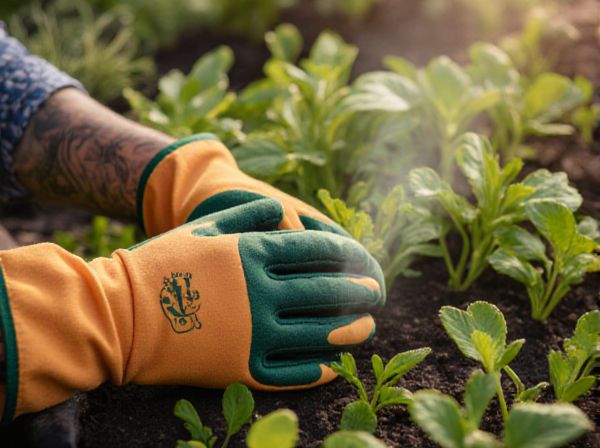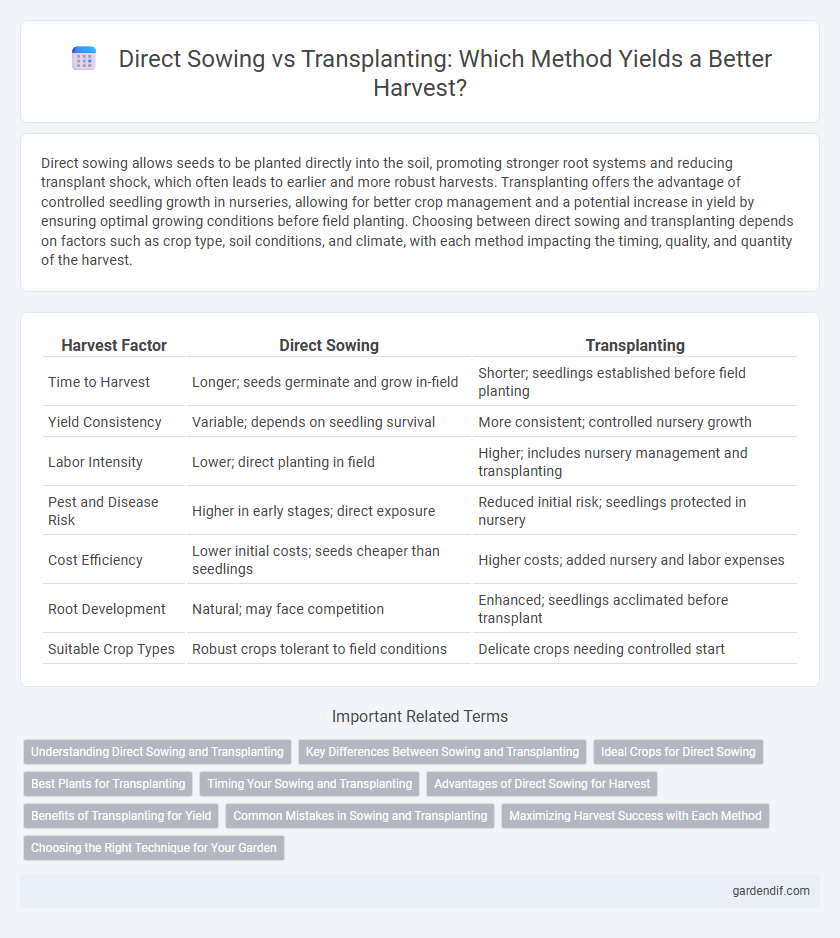
Direct Sowing vs Transplanting for Harvest Illustration
Direct sowing allows seeds to be planted directly into the soil, promoting stronger root systems and reducing transplant shock, which often leads to earlier and more robust harvests. Transplanting offers the advantage of controlled seedling growth in nurseries, allowing for better crop management and a potential increase in yield by ensuring optimal growing conditions before field planting. Choosing between direct sowing and transplanting depends on factors such as crop type, soil conditions, and climate, with each method impacting the timing, quality, and quantity of the harvest.
Table of Comparison
| Harvest Factor | Direct Sowing | Transplanting |
|---|---|---|
| Time to Harvest | Longer; seeds germinate and grow in-field | Shorter; seedlings established before field planting |
| Yield Consistency | Variable; depends on seedling survival | More consistent; controlled nursery growth |
| Labor Intensity | Lower; direct planting in field | Higher; includes nursery management and transplanting |
| Pest and Disease Risk | Higher in early stages; direct exposure | Reduced initial risk; seedlings protected in nursery |
| Cost Efficiency | Lower initial costs; seeds cheaper than seedlings | Higher costs; added nursery and labor expenses |
| Root Development | Natural; may face competition | Enhanced; seedlings acclimated before transplant |
| Suitable Crop Types | Robust crops tolerant to field conditions | Delicate crops needing controlled start |
Understanding Direct Sowing and Transplanting
Direct sowing involves planting seeds directly into the soil, promoting natural root development and reducing transplant shock, which can lead to faster crop establishment and yield. Transplanting, by contrast, allows seedlings to be nurtured in controlled environments before being moved to the field, improving early growth success and enabling better spacing management. Understanding the differences in root system development, growth timing, and resource allocation is crucial for optimizing harvest outcomes based on specific crop requirements and environmental conditions.
Key Differences Between Sowing and Transplanting
Direct sowing involves planting seeds directly into the soil, promoting faster root establishment and reducing initial labor costs. Transplanting requires raising seedlings in controlled environments before moving them to the field, enhancing early growth and increasing survival rates. Key differences include variations in crop maturity time, weed control efficiency, and adaptation to climate conditions, impacting overall harvest yield and quality.
Ideal Crops for Direct Sowing
Ideal crops for direct sowing include root vegetables such as carrots and beets, as well as grains like wheat and corn, which benefit from minimal root disturbance. Legumes like peas and beans also thrive when sown directly due to their tolerance for soil variability. Direct sowing enhances early root establishment and reduces transplant shock, promoting efficient nutrient uptake and consistent harvest yields.
Best Plants for Transplanting
Tomatoes, peppers, and eggplants are among the best plants for transplanting due to their longer growing seasons and sensitivity to early frost. Transplanting these seedlings provides a controlled environment for initial growth, ensuring stronger plants and higher yields at harvest time. Crops like lettuce and carrots, which have shorter growing cycles, are better suited for direct sowing to avoid transplant shock and root disturbance.
Timing Your Sowing and Transplanting
Timing your sowing and transplanting directly impacts harvest quality and yield. Direct sowing allows seeds to germinate and grow in situ, often resulting in stronger root systems and reduced transplant shock, which can lead to earlier harvests. Transplanting requires careful scheduling to ensure seedlings are mature enough to withstand field conditions, optimizing growth periods and synchronizing crop maturity for efficient harvesting.
Advantages of Direct Sowing for Harvest
Direct sowing accelerates the harvest timeline by eliminating the transplant shock associated with moving seedlings, resulting in faster crop maturity. This method reduces labor and costs related to nursery management and transplantation, enhancing overall operational efficiency. Soils directly seeded often develop stronger root systems, improving nutrient uptake and leading to higher yield stability at harvest.
Benefits of Transplanting for Yield
Transplanting enhances crop yield by providing seedlings with a controlled environment during early growth stages, reducing mortality and ensuring uniform plant development. This method allows for earlier crop establishment and extended growing periods, leading to higher productivity compared to direct sowing. Improved root systems and better spacing achieved through transplanting maximize nutrient uptake and reduce competition, directly boosting harvest volume and quality.
Common Mistakes in Sowing and Transplanting
Common mistakes in direct sowing include planting seeds too deeply or too shallowly, leading to poor germination rates and uneven crop emergence. In transplanting, errors such as damaging roots, transplanting at the wrong seedling age, or insufficient hardening off often result in transplant shock and reduced yield. Both methods require precise timing and proper soil preparation to optimize plant establishment and maximize harvest quality.
Maximizing Harvest Success with Each Method
Direct sowing offers cost-effective planting with reduced transplant shock, promoting strong root development and faster establishment in the field. Transplanting allows for early season growth and better control over plant spacing, minimizing competition and optimizing yield potential. Selecting the appropriate method based on crop type, soil conditions, and climate ensures maximum harvest success by aligning plant development with environmental factors.
Choosing the Right Technique for Your Garden
Direct sowing allows seeds to grow naturally in their final location, promoting strong root systems and minimal transplant shock, ideal for gardeners seeking efficient, low-maintenance planting. Transplanting offers greater control over seedling development, enabling early starts indoors and protection from adverse weather, which benefits slow-growing or delicate crops. Selecting the right technique depends on crop type, climate conditions, and garden space, ensuring optimal growth and successful harvests.
Direct Sowing vs Transplanting for Harvest Infographic

 gardendif.com
gardendif.com